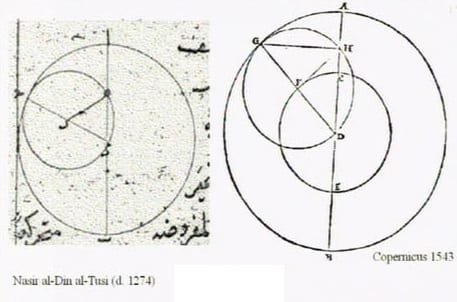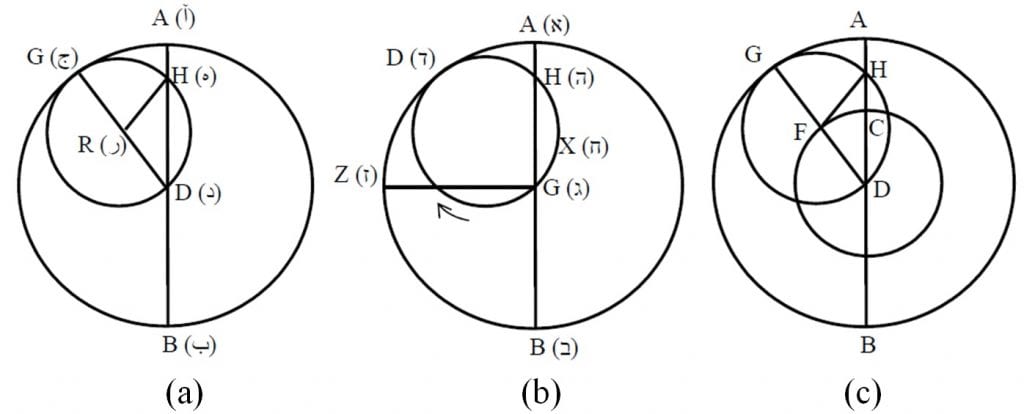Normally I would not discuss my publications unrelated to my main field of research (mechanical engineering and surface science) in this blog. However, this one, although in a History peer-reviewed journal, deals with the history of mechanics and astronomy. More particularly, with the creation of the Copernican system.
M. Nosonovsky. “Abner of Burgos: The Missing Link between Nasir al-Din al-Tusi and Nicolaus Copernicus?” Zutot 15 (2018) 25-30 DOI 10.1163/18750214-12151070
PDF link
It has been known for about 50 years that Copernicus was likely aware about the mathematical theorem called “the Tusi couple” after a medieval Persian astronomer Nasir al Din al Tusi (محمد بن محمد بن حسن طوسی). The Tusi couple is considered by historians of astronomy a key element of the Copernican heliocentric system. Historians showed that Persian astronomers of the 13th century from the Maragha school in southern Azerbaijan came very close to the discovery of the heliocentric Copernicus planetary system. Although these astronomers did not claim explicitly that the sun is located in the center of the planetary system, their mathematical formalism was identical with that of Nicolaus Copernicus and unlike the earlier formalism employed by the geocentric Ptolemaic system. Furthermore, there is indirect evidence that Copernicus (1473–1543) was familiar with the work of Nasir al-Din al-Tusi (1201–1274), the founder of the Maragha observatory, and that the discoveries of al-Tusi were the necessary key element to finalize the Copernicus system. However, how the knowledge of the Muslim scholars was transmitted to Europe, was a matter of debate.
Willy Hartner showed in 1973 that it is likely that Copernicus was familiar with al-Tusi’s work, since there is a striking similarity between the drawings of Copernicus in his De Revolutionibus orbitum celestium (On revolutions of celestial spheres) and of al-Tusi in his Tadhkira fi ʿulm al-haʾya (Memorandum on the science of astronomy). The Latin notation of Copernicus’s diagrams followed the Arabic notation of al-Tusi. Thus, where Tusi uses the Arabic letter ا (‘Alif), Copernicus uses “A”, where Tusi uses ب Ba, Copernicus uses “B,” and so on. Below is a figure from Prof. George Saliba’s website showing both Tusi’s and Copernicus’ drawings:

Quite a while ago I noticed that the Tusi couple is mentioned also in a Hebrew medieval treatise מישר עקוב Meyasher ʿaqov (Rectifying the Curved) by a Spanish Jewish author named Abner of Burgos (c. 1270–1340), also known as Alfonso de Valladolid after his conversion to Christianity. The treatise was published and translated into Russian by a Russian scholar Gita Gluskina in 1983 on the basis of a medieval manuscript. The primary focus of Meyasher ʿaqov has little to do with Tusi and Copernicus; however, it brings the Tusi couple as one of many examples, thus proving that Abner was familiar with Tusi’s work and, therefore, that this work was known in Europe. Note that many medieval Arabic scientific texts were translated into Hebrew and than into Latin by Spanish Jews.
Furthermore, Abner’s notation is at least partially parallel to that of Tusi and Copernicus. Where Tusi uses the Arabic letter ا (‘Alif) and Copernicus uses “A”, Abner uses Hebrew א ‘Aleph, where Tusi uses ب Ba and Copernicus uses “B”, Abner uses Hebrew ב Bet, and so on.

Figure 1. (a) The Tusi couple. As the small sphere (DGH) rotates upon the big sphere (ADB), the point A oscillates along the straight line AB. Original Arabic notation of al-Tusi is shown in parentheses according to Hartner, ‘Copernicus,’ 421. (b) Our reconstruction of Statement 33 by Abner. (c) The schematics and original notation used by Copernicus (based on Hartner, ‘Copernicus,’ 422).
Below are some illustrations, which are not parts of the paper. The title page of the publication by Gluskina, the Russian translation and the original manuscript in Hebrew of Abner’s “Statement 33” (the Tusi couple).


